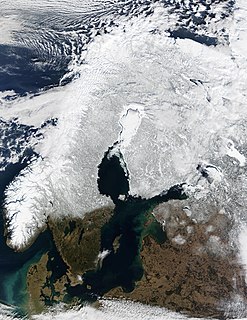
Scandinavia is a subregion in Northern Europe, with strong historical, cultural, and linguistic ties. The term Scandinavia in local usage covers the three kingdoms of Denmark, Norway, and Sweden. The majority national languages of these three belong to the Scandinavian dialect continuum, and are mutually intelligible North Germanic languages.

The Viking Age was the period during the Middle Ages when Norsemen known as Vikings undertook large-scale raiding, colonizing, conquest and trading throughout Europe, and reached North America. It followed the Migration Period and the Germanic Iron Age. The Viking Age applies not only to their homeland of Scandinavia, but to any place significantly settled by Scandinavians during the period. The Scandinavians of the Viking Age are often referred to as Vikings as well as Norsemen, although few of them were Vikings in the technical sense.

In geology, a fjord or fiord is a long, narrow inlet with steep sides or cliffs, created by a glacier. There are many fjords on the coasts of Alaska, Antarctica, British Columbia, Chile, Denmark, Greenland, the Faroe Islands, Iceland, Ireland, Kamchatka, the Kerguelen Islands, New Zealand, Norway, Novaya Zemlya, Labrador, Nunavut, Newfoundland, Quebec, Scotland, South Georgia Island, Staten Island (Argentina), and Washington state. Norway's coastline is estimated at 29,000 kilometres (18,000 mi) with nearly 1,200 fjords, but only 2,500 kilometres (1,600 mi) when fjords are excluded.

Lutefisk is dried whitefish. It is made from aged stockfish, or dried and salted cod, pickled in lye. It is gelatinous in texture after being rehydrated for days prior to eating.

The Norsemen were a North Germanic ethnolinguistic group of the Early Middle Ages, during which they spoke the Old Norse language. The language belongs to the North Germanic branch of the Indo-European languages and is the predecessor of the modern Germanic languages of Scandinavia. During the late 8th century, Norsemen embarked on a large-scale expansion in all directions, giving rise to the Viking Age. In English-language scholarship since the 19th century, Norse seafaring traders, settlers and warriors have commonly been referred to as Vikings. The identity of Norsemen derived into their modern descendants, the Danes, Icelanders, Faroe Islanders, Norwegians, and Swedes, who are now generally referred to as 'Scandinavians' rather than Norsemen.

Scandinavian Airlines, usually known as SAS, is the flag carrier of Denmark, Norway and Sweden. SAS is an abbreviation of the company's full name, Scandinavian Airlines System or legally Scandinavian Airlines System Denmark-Norway-Sweden. Part of the SAS Group and headquartered at the SAS Frösundavik Office Building in Solna, Sweden, the airline operates 180 aircraft to 90 destinations. The airline's main hub is at Copenhagen-Kastrup Airport, with connections to 109 destinations around the world. Stockholm Arlanda Airport is the second largest hub and Oslo Airport, Gardermoen being the third major hub of SAS. Minor hubs also exist at Bergen Airport, Flesland, Göteborg Landvetter Airport, Stavanger Airport, Sola, and Trondheim Airport, Værnes. SAS Cargo is an independent, wholly owned subsidiary of Scandinavian Airlines and its main office is at Copenhagen Airport.

Baptist General Conference of Canada (BGCC) is a national body of evangelical Baptist churches introduced to Canada by Swedish Baptists that emerged in Radical Pietism late in the 19th century. From its beginning among Scandinavian immigrants, the BGCC has grown to a network of autonomous churches from Vancouver Island to Nova Scotia.
The Vikings were seafaring Scandinavians.

Norwegians are a North Germanic ethnic group native to Norway. They share a common culture and speak the Norwegian language. Norwegian people and their descendants are found in migrant communities worldwide, notably in the United States, Canada, Australia, New Zealand and South Africa.
North-Central American English is an American English dialect native to the Upper Midwestern United States, an area that somewhat overlaps with speakers of the separate Inland North dialect centered more around the eastern Great Lakes region. If a strict cot–caught merger is used to define the North-Central regional dialect, it covers the Upper Peninsula of Michigan, the northern border of Wisconsin, the whole northern half of Minnesota, some of northern South Dakota, and most of North Dakota; otherwise, the dialect may be considered to extend to all of Minnesota, North Dakota, most of South Dakota, northern Iowa, and all of Wisconsin outside of metropolitan Milwaukee.
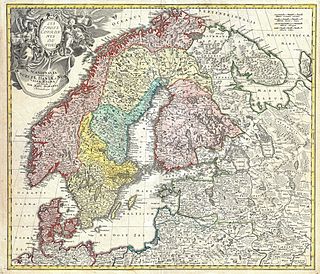
The history of Scandinavia is the history of the geographical region of Scandinavia and its peoples. The region is in northern Europe, and consists of Denmark, Norway, and Sweden. Finland and Iceland are at times, especially in English-speaking contexts, considered part of Scandinavia.
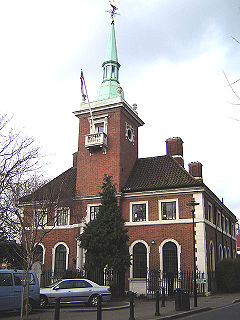
The Norwegian Church Abroad or The Norwegian Seamen’s Church is a religious organisation serving Norwegians and other Scandinavians travelling abroad. Founded in 1864, The Norwegian Seamen’s Mission – Sjømannsmisjonen – was established to secure the moral and religious education of Scandinavian seafarers, but also to give them a "breathing room" where a fellow countryman was available to lend an ear and give some attention. Today, the churches and their staff together with travelling pastors around the globe represent a "resource center" for all Norwegians travelling internationally.

Population of British Columbia 5.071 million (2019)
Norwegian Canadians refer to Canadian citizens who identify themselves as being of full or partial Norwegian ancestry, or people who emigrated from Norway and reside in Canada.

Lund is a small craft harbour and unincorporated village in qathet Regional District, British Columbia, Canada. It is along the northern part of the Strait of Georgia on the mainland BC coast. The main landmark in the village is the Lund Hotel, established in 1905. By boat from Lund, the Copeland Islands and Desolation Sound, are nearby. Lund is home to many shops and services including a general store, a restaurant overlooking the water, kayak and adventure tourism stores, and Nancy's Bakery, a favourite of locals and tourists.

Scandinavian studies is an interdisciplinary academic field of area studies, mainly in the United States and Germany, that primarily focuses on the Scandinavian languages and cultural studies pertaining to Scandinavia and Scandinavian language and culture in the other Nordic countries. While Scandinavia is defined as Denmark, Norway and Sweden, the term Scandinavian in an ethnic, cultural and linguistic sense is often used synonymously with North Germanic and also refers to the peoples and languages of the Faroe Islands and Iceland; furthermore a minority in Finland are ethnically Scandinavian and speak Swedish natively.

Bridget, Briget or Brigid is a Gaelic/Irish female name derived from the noun brígh, meaning "power, strength, vigor, virtue". An alternate meaning of the name is "exalted one". Its popularity, especially in Ireland, is largely related to the popularity of Saint Brigid of Kildare, who was so popular in Ireland she was known as "Mary of the Gael". This saint took on many of the characteristics of the early Celtic goddess Brigid, who was the goddess of agriculture and healing and possibly also of poetry and fire. One of her epithets was "Brigid of the Holy Fire". In German and Scandinavian countries, the popularity of the name spread due to Saint Bridget of Sweden.
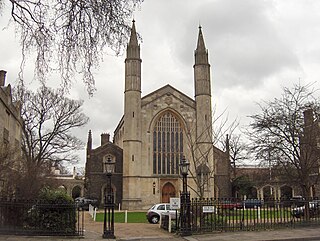
The Danish Seamen’s Church and Church Abroad is a Protestant church. It was founded 1 January 2004 as the result of a fusion between the Danish Church Abroad and the Danish Seamen's Church in foreign ports. It was established to help Danes travelling abroad, particularly seafarers and migrant workers.
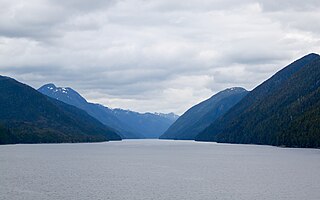
Grenville Channel is a strait on the North Coast of British Columbia, Canada, located between Pitt Island and the mainland to the south of Prince Rupert. The channel is part of the Inside Passage shipping route, about 45 nautical miles long and is 0.2 nautical miles wide at the narrowest part.
The Scandinavian diaspora may refer to

















